The year of 2013 has brought us, photographers, a number of great new speedlights aimed to fit the needs of the professionals, hobbyists, and the beginners. However, many flashes released in the recent years can also be a great choice today, since the portable flash market is not as dynamic as the camera market. In this post, we list top 5 speedlights that are among our favorites, and, as we believe, they will be a good buy during 2013 holiday season and throughout 2014. This list is best suited for advanced photographers, but some of the flashes can also be a great buy for novices who want to learn flash photography and grow the skills over time.
Every major camera manufacturer offers a lineup of portable flashes for its cameras. These speedlights are typically a great choice, from the entry-level units to the top-of-the-line flashguns, like Canon Speedlite 600EX-RT, Nikon Speedlight SB-910, Sony HVL-F58AM, etc. However, buying a flash of your camera brand often means paying a premium price. In this article, we focus on the third-party speedlights. They often come at a lower price, offer similar features, and even deliver some unique functions not found anywhere else.
The Nissin MG8000 speedlight is truly unique. It is the only portable flash on the market today that does not suffer from the overheating problem when fired repeatedly at full power. Many speedlights have a thermal cut-off feature that either slows down the recycling or prevents the flash from firing until the internal temperature of the unit drops to an acceptable level. Nissin MG8000 Extreme employs a quartz tube (a special ceramic insulation) and ventilation holes. MG8000 can fire up to 1000 times without stopping, which is remarkable.
Another unique feature of Nissin MG8000 Extreme is the color LCD screen and the color-coded menus, which make the flash easier to control. On top of that, the menu rotates when the flash is positioned sideways, which aids usability.
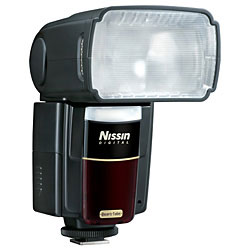 |
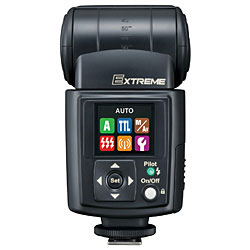 |
Like some of the other Nissin flashes, MG8000 does not have a battery compartment door (which can potentially break off). It uses a battery magazine instead, which makes the battery reload faster and more convenient.
MG8000 Extreme features a secondary flash (also known as a sub-flash or a wink light), which can be used as a fill light when the flash head is pointed elsewhere for bouncing. Neither Canon, Nikon, or Sony offer a secondary flash built in their flashguns.
Nissin MG8000 Extreme packs virtually all the features you would expect from a professional level speedlight: high guide number, wireless master and slave functions, optical slave modes, PC sync port, external battery pack socket, high-speed sync, etc.
There are a few quirks, however. We found that controlling the flash via the in-camera menus is limited. Also, we wished the LCD screen was a bit more responsive. The flash head does not have a catchlight card, and the wide-angle diffuser is a clip-on instead of being a built-in.
Finally, note that Nissin MG8000 Extreme is a premium flash. While it is among our favorites, it is also one of the most expensive speedlights. So, it is mostly to be used by professionals who shoot in a fast-paced environment where the overheating may become an issue.
Here are the current Amazon prices: for Canon, for Nikon
.
Phottix Mitros+ is the only third-party flash that features built-in radio triggering capabilities and delivers great overall performance. Phottix introduced its first flash, Mitros, earlier this year, and it was very well-received. (See our Phottix Mitros review for more details.)
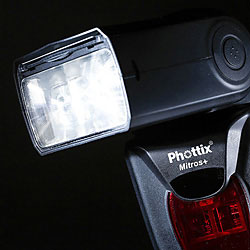 |
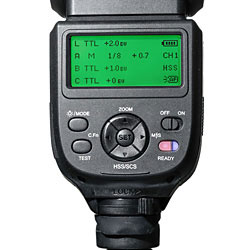 |
Mitros+ is essentially the same as the Mitros unit but with the radio triggering functions that rival the great Canon 600EX-RT :). Not only Mitros+ can do virtually anything 600EX-RT can, but it also works with the majority of the Canon camera bodies, whereas the fancy features of the the Canon flash are only available with the latest cameras, like Canon 5D Mark III. Combined with the savings of 20-30% over the price of 600EX-RT, the feature set of Mitros+ can look very attractive. (Check the current Amazon price: Phottix Mitros+ for Canon)
Please note, however, that as with Canon 600EX-RT, by getting Mitros+ you are buying into the system. Phottix Mitros+ has the radio functions of the Phottix Odin and Phottix Strato triggers built into it. Therefore, it works with those triggers and other Mitros+ units, but it does not work with any of the Canon radio gear. Phottix Mitros+ is fully compatible, however, with all the Canon "traditional" optical TTL and manual triggering, including Master and Slave functions.
Another advantage of Phottix Mitros+ is that, by using Odin or Strato triggers, you can mix the Mitros+ units with speedlights made by other manufacturers, while Canon 600EX-RT can only play with its own kind and nothing else.
Mitros+ is currently available for Canon, but we'd expect a Nikon version to follow some time soon. It means that the Nikon shooters will have something that even Nikon cannot offer them at the moment.
We found that Phottix Mitros+ puts out less power than specified. While the Guide Number matches the one of the 600EX unit, in our tests, the maximum light output was about 1/2-stop less. Also, the external battery socket requires an adapter to be used with the Canon power packs. Even though the adapter is included with the flash, we prefer being able to plug the power pack directly.
Because of its moderate price point and the great feature set, Phottix Mitros+ should appeal to both, photography professionals and hobbyists.
Metz Mecablitz 52 AF-1 deserves a spot on our list of top 5 speedlights for a number of innovations and the legendary German quality. Metz 52 AF-1 is the world's first flashgun with a touchscreen interface that certainly delivers a fresh experience and has a number of advantages over physical buttons. (For more details, refer to our Metz 52 AF-1 vs. Metz 50 AF-1 comparison). Similar to Nissin MG8000, Metz Mecablitz 52 AF-1 has an orientation sensor that allows the flash menu to rotate when the flash itself is rotated.
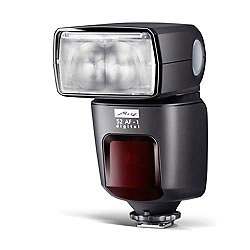 |
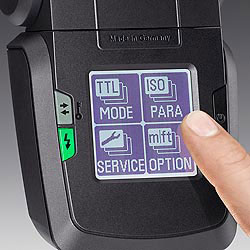 |
Many flashes offer "dumb" optical triggering options, when they can be triggered by flash units of other TTL systems or manual strobes. In such modes, the optical slave must ignore various sequences of TTL pre-flashes before firing with the main light burst. There are plenty of variations of the pre-flash signals that not only depend on the brand but also on the settings of the master flash. Metz 52 AF-1 "knows" a lot of systems and it can “learn” the ones that it does not know. Its unique Learn function can be used to "teach" Mecablitz 52 AF-1 the signals of virtually any flash, so the two units can work together. This means that 52 AF-1 will be able to play along as a slave with virtually any future flash and not just the flashes available today.
Metz is the only brand to offer Extended Zoom mode in its flashes, and with Mecablitz 52 AF-1, it introduced Spot Zoom mode. The idea of both modes is to automatically offset the flash zoom from the lens zoom value to achieve the lighter shadows in case of Extended Zoom (see out extended zoom test for more details) and the vignetting effect with Spot Zoom. For example, in Spot Zoom, if you set your lens to 50mm, the flash will set itself to 70mm creating some light falloff around the edges of the frame.
Metz Mecablitz 52 AF-1 is a mid-range flashgun. It offers a lower Guide Number of 52 and it is missing a couple of professional features, like an external battery pack connector and a PC or mini-phone sync port. Unlike many other flashes in its range, however, it does not limit the wireless functions. It delivers a full range of both slave and master functions with the support of all the channels and groups.
Lastly, Metz 52 AF-1 is one of the few third-party flashes that are available for the majority of the camera brands. Current Amazon prices: for Canon, for Nikon
, for Sony
, for Pentax
, for Olympus/Panasonic
.
Metz Mecablitz 52 AF-1 is definitely a great choice for anyone from a novice to a pro. Unless you absolutely require a battery pack connection or the highest possible light output, Metz 52 AF-1 is a safe bet.
LumoPro LP180 is the only manual flash on this top 5 list. Even though it does not offer TTL functionality, it is still among our favorites for its innovations, build quality, and a distinct look.
There are two features offered by LumoPro LP180 that cannot be found in any other portable flash at the moment: built-in light stand mount and a built-in gel holder. The standard 1/4-20 mount on the right side of the flash head allows you to mount LP180 directly onto an umbrella swivel adapter or a light stand, for example. The built-in filter holder is a quick-and-dirty solution for your gelling needs. The gel holder is not perfect, but it is quite handy considering that LP180 comes with 22 free filters. For more information, please refer to our in-depth review of LumoPro LP180 Manual flash
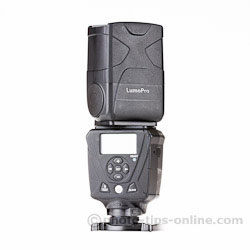 |
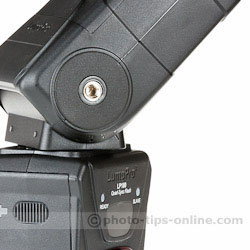 |
LumoPro LP180 is one of the two quad-sync flashes on the market today (the other one is Nissin Di700). Being a quad-sync means being able to trigger via hot-shoe, optical signal, PC sync socket, and a mini-phone port. The quad-sync flashes are the best ones for the off-camera photography, as they offer the most flexibility for connecting your photo gear.
While LumoPro LP180 cannot "learn" to skip the control sequences from other flashes, like Metz 52 AF-1 do, it has 11 optical slave modes to choose from, which gets you covered for a vast majority of situations.
The maximum light output of LumoPro LP180 is equivalent to the top flashes from Canon and Nikon. The controls are extremely intuitive and easy to use. The quick-release lever lock on the mounting foot is the best on the market today (even better than Canon or Nikon).
As a final note, LumoPro LP180 has an unusual look for a speedlight. While we really like it, some people may not be too excited about it, but for the price, it makes a great buy, especially if you need an off-camera flash and want to save money by not paying for TTL features.
Sigma has been making speedlights for about 10 years now. The current pinnacle of the company's work is Sigma EF-610 DG Super. It has a lot to offer: high Guide Number of 61, master and slave wireless functions, high-speed sync, second curtain sync, modeling light, stroboscopic mode, etc. Sigma EF-610 DG Super does lack a PC sync port and an external battery pack socket, which is a must-have for some professional photographers.
 |
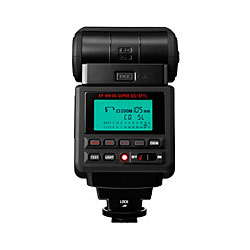 |
We have not tested the Sigma EF-610 DG Super model, but we had a positive experience with its predecessor, a very similar flash with a lower Guide Number. The build quality was good and the flash performed well in a variety of situations.
While Sigma EF-610 DG Super does not really stand out in terms of innovation, it is included in our list of the top 5 flashes because of its value. At about half of the price of the similar Canon, Nikon, or Sony units, it is packed with a set of features that can satisfy the needs of photographers of all levels. Sure, some pro photographers may need to look somewhere else to find a flash that is best suited for their specific applications, but for many, Sigma EF-610 DG Super would be enough. Also, imagine the savings when you need to buy two or three flashes for multiple light setups. The savings can add up to a very nice number. If you are on a budget, getting two Sigma flashes instead, say, one Nikon, can make a world of difference to you, because using two light sources instead of one can take your photography to a completely new level.
Sigma EF-610 DG Super is available at Amazon for Canon, for Nikon
, for Sony
, and for Pentax
By working on this list of the top 5 speedlights, we were trying to identify the flashes that were unique in their own way. Each of these flashes caters to somewhat different applications, but they all are great all-around units. There are plenty of other models from the manufacturers mentioned here, as well as from the seasoned manufacturers or the ones that are fairly new to the game. There are a lot of options to chose from, and we hope this review can be help you make a decision on your next speedlight purchase, or at least, it can be a good starting point in your search for a flashgun.
So, what speedlight would you most likely buy next? Vote below and leave your comments and questions.